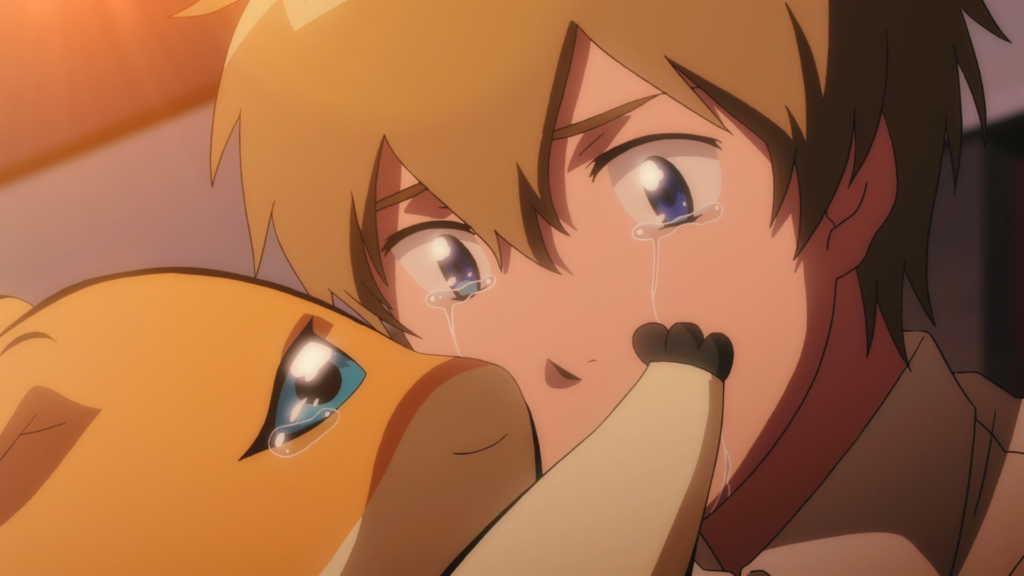Digimon Adventure tri. The Movie Chapter 3: Confession Review
Tai and the rest of the Digidestined are still reeling from the sudden and disturbing infection of Meicoomon, which caused her to go berserk and destroy Leomon before disappearing into the distortion. Desperate to find out what caused the sudden transformation, Izzy questions Meicoomon’s partner, Meiko, but she’s an emotional wreck, still heavily shaken and her unable to give any answers. To prevent the infection spreading further, Izzy quarantines Agumon and the other Digimon within his personal server. Despite this, Patamon starts to show signs of illness, causing severe distress for TK.
Up to this point, the Digimon Tri franchise has been hit and miss. Chapter 1 was a great start that reunited the cast of the TV show and set the stage for the second film, only for Chapter 2 to come along and be a disappointing and meandering slog, so my expectation for Chapter 3 was something along the lines of cautious optimism, hoping it would be a return to form. Upon watching it, I was happy to see that Digimon Tri Chapter 3: Confession is not just an improvement over the rather lacklustre Chapter 2, but the best entry in the film series to date.
By far the biggest issue with Tri Chapter 2 was the almost total lack of plot. It was slow moving and full of time-wasting filler, padding out a movie that was already pretty short, and I can’t help but feel that the writers themselves must have realised how lacking it was, because Tri Chapter 3 is such a huge improvement in this area. The story is tight and focussed, and barely wastes a minute from the start to the end.
Focusing on the aftermath of Meicoomon’s infection at the end of Tri Chapter 2, there is a strong emotional core at the heart of Tri Chapter 3’s story, being all about the potential infection of all of the partner Digimon, which, for someone who has been a long-time fan of the franchise, is a very effective means of injecting tension into the series. Seeing the Digidestined having to fight their partners is genuinely quite heartrending, especially if you’ve witnessed the growth of their bond over the course of the franchise, not to mention the implication that the infected Digimon would have to be destroyed. Unlike the original TV show, where Digimon who die are simply reborn within the digital world, there’s also the fact that any potential Digimon death within the real world (and the void between worlds) would become permanent. With a handful of exceptions, the Digimon franchise has always been quite soft on the topic of death, as well you’d expect from a children’s anime, however, given that Tri is meant to be for a more mature audience who grew up watching Digimon Adventure, it makes a lot of sense for this approach to mortality to be altered, and the way it’s done is quite clever and in keeping with the original lore.
The whole film has a really melancholic tone, which is no surprise given the subject matter, and this feels really fresh and new for Digimon, which has generally kept a lighthearted tone in the past, barring the oddly dark Digimon Tamers. This new tone is enhanced by returning composer Go Sakabe, whose music helps to accentuate the mood and gives the emotional moments poignancy.
Unlike both prior entries in the Tri franchise, Chapter 3 doesn’t let the emphasis on either story take away from the characters, or vice versa, finally managing to strike a good balance between the two. Whilst I wouldn’t say there’s any particular focus on any of the characters here (although TK probably gets the most screen time), we still get a fair amount of depth added to the cast as a whole, as we see how each of the Digidestined and their partners react to the infection, and how they deal with the realisation that they might lose each other. It’s all rather compelling and expertly interwoven with the plot, so it doesn’t feel as if it’s slowing down too much in order to give us these character moments.
Fans of the action-centric parts of Digimon may be slightly disappointed with Tri Chapter 3, with only one real prominent action scene that takes place over an hour in, but the quality of both the story and characters this time around means that the lack of fight scenes isn’t particularly noticeable, at least to me, and the big scene we do get is so great that it more than makes up for it.
If you’ve seen either of the earlier Tri movies (which if you haven’t, I’d recommend watching before this one!) you know what to expect in terms of the animation quality and voice acting; both remaining as consistently great as before, but don’t feature any notable improvements, additions or stand-outs.
In Summary
Digimon Tri Chapter 3: Confession is far and away the best entry in the series so far, having a balance of a great story and character development, with a generous dose of action for good measure.









